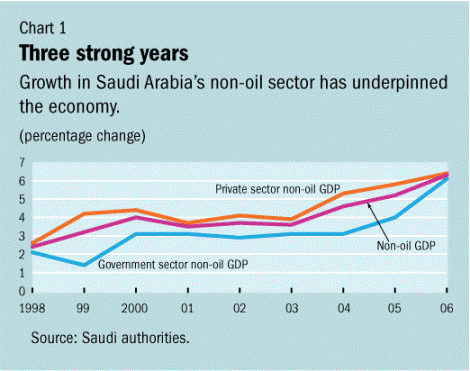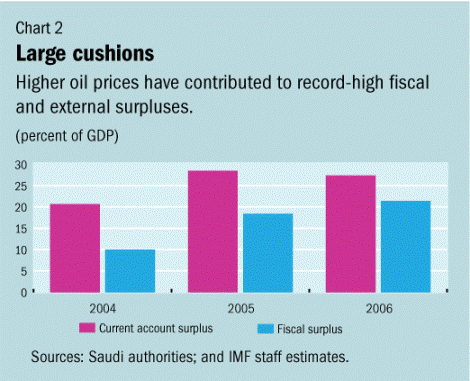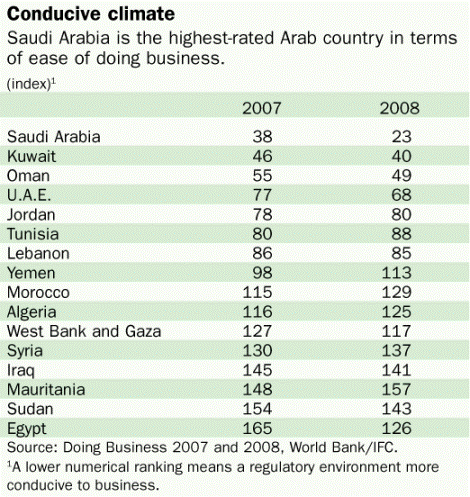
Typical street scene in Santa Ana, El Salvador. (Photo: iStock)
IMF Survey: Non-Oil Sector Supports Saudi Growth
November 14, 2007
- Non-oil sector growth is strong, accelerating for third successive year
- Structural reforms have boosted private sector, improved business climate
- Reforms to create private sector jobs are ongoing priority
Saudi Arabia, buoyed by record-high oil prices, is enjoying solid growth and low inflation, a trend that is expected to continue over the medium term.

Dates at market in Riyadh, Saudi Arabia where, IMF says, non-oil private sector set to benefit from improved business climate (photo: Hassan Anmar/AFP)
ANNUAL ECONOMIC HEALTH CHECK
Growth for 2007 is projected at 4.1 percent despite an expected contraction in oil production and is supported by strong activity in the non-oil sector. Inflation will remain in the range of 3 percent.
Over the next five years (2008-12), real growth is expected to average 5.6 percent. Although public sector demand will continue to be an important engine for growth, non-oil activity in the private sector will expand further because of the government's continued implementation of structural reforms, which have improved the business climate (see Chart 1).

The main downside risk to the favorable medium-term outlook is the unlikely event of an unexpected decline in global oil demand, says the IMF in its annual "Article IV" consultation with the Saudi kingdom.
High fiscal, external surpluses
Higher oil prices boosted the country's overall fiscal surplus to 21.4 percent of GDP in 2006, despite a significant increase in government spending on social sector programs, especially education; transfers to fund housing and socioeconomic development; and capital projects. The authorities intend to continue with their expansionary fiscal stance, with spending that will underpin private sector growth and poverty alleviation. The IMF observes that replacing petroleum product subsidies with targeted direct social assistance would also be a step in the right direction.
The fiscal surplus (see Chart 2) enabled the authorities to reduce the central government's gross domestic debt by an additional 11 percentage points in 2006, to 27.9 percent of GDP. Higher oil prices more than offset the effect of the small contraction in oil output, resulting in a $95.5 billion current account surplus (27.4 percent of GDP), despite a 29 percent increase in imports of goods and nonfactor services. Inward foreign direct investment in a broad range of domestic projects increased sharply (51 percent) to $18.3 billion.

Although recent fiscal surpluses have considerably enhanced Saudi Arabia's fiscal flexibility and long-term sustainability, the IMF notes that efficient implementation of the country's spending plans over the medium term will require a significant strengthening of public expenditure management, including properly managing underlying contingent liabilities with regard to investments under public-private partnerships.
Participation in multilateral consultation
As one of the five parties to the IMF's first multilateral consultation on global imbalances, Saudi Arabia plans to use its recent large increases in revenue to boost spending on social and infrastructure investments and on expanding oil sector capacity. These policies are driven by Saudi Arabia's domestic objectives of sustaining and diversifying economic growth and increasing the population's living standards. Implementation of these homegrown policies will increase imports of goods and services and thereby contribute to the reduction of global imbalances.
Supporting global oil market stability
Endowed with about one-fourth of the world's proven crude oil reserves, Saudi Arabia plays a key role in stabilizing the international oil market through policies designed to maintain production in line with global demand conditions. The country's oil production capacity has been expanded over the past several years to meet the world's rising demand and to build up spare capacity, which is necessary to meet unexpected increases in world demand or drops in world supply.
The Saudi national oil company, Aramco, is proceeding with an $80 billion investment plan to increase oil production capacity to 12.5 million barrels per day (mbd) by the end of 2009, expand gas-processing facilities, and increase oil-refining capacity at home and abroad by almost 50 percent to 5.9 mbd. The IMF notes that close monitoring of tightening labor market conditions to ensure smooth implementation of investment projects would also be important.
The authorities are also considering additional investments aimed at increasing capacity to about 13.1 mbd by 2013. Saudi Arabia's support was instrumental in the recent decision of the Organization of the Petroleum Exporting Countries to increase the output quota by 0.5 mbd to meet the growing demand for oil.
Structural reforms
Implementation of broad-based structural reforms over the past several years has greatly improved Saudi Arabia's business climate. The World Bank/International Finance Corporation report Doing Business 2008 ranks the country among the top 10 reformers in 2006/07.
The report also places Saudi Arabia in the fifteenth percentile (of 178 countries) and ranks it the top Arab country in terms of the ease of doing business (see table). Realization of its ambitious structural reform agenda also paved the way for the country's acceptance in 2005 into the World Trade Organization, which is likely to provide another boost to the economy.

The primary objective of structural reforms is to create more jobs for Saudi nationals. This objective can be achieved through further diversification of the economy, because the oil sector—though a substantial source of revenue—is not a major source of employment.
Employment opportunities
Turning the private non-oil sector into the main source of growth will ensure creation of employment opportunities and secure sustainable overall economic development in the long term. The government supports increasing the competitiveness of the Saudi labor force by improving the education system and providing specially designed training programs.
With some elements of the structural reform agenda completed, it is important that the government design a new and comprehensive plan to further promote private non-oil sector growth and competitiveness in the sectors in which the country has comparative advantage, create a level playing field for market participants, and allow market forces to work.
The next phase of reforms should include, among other elements, continuation of the privatization process, further outsourcing of public sector activities to the private sector and a strengthening of public-private partnerships, further development of the domestic financial securities market, and modernization of the regulatory and legislative frameworks.







